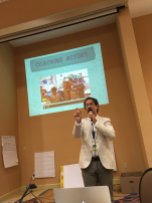Teachers unaccustomed to speaking the target language in class are often a bit lost when it comes to providing input. Instead, the more familiar rule-based lectures and paired speaking activities of PPP (present, practice, produce), target culture projects, and perhaps target language movies all become quite alluring, seducing teachers back to the pedagogy of yore. Here’s a way to conceptualize class in a clearer way that maximizes input:
- Talk about something
- Read something
Now, from the student perspective, this would be “listen & read,” but the “talk” portion of class is very much led by the teacher, especially in beginning years, so it’s easier to think of this in terms of what you, the teacher, must do. Don’t get fooled by anyone thinking this is the kind of “teacher-centered” lesson that’s frowned upon. The content is student-centered, it’s just that students can’t express themselves fully in the target language. They don’t have to, and this is expected. They need input. Case closed. The “read” portion could be any reading activity, either independent, led by you, in pairs, groups, or all of the above…
Continue reading







